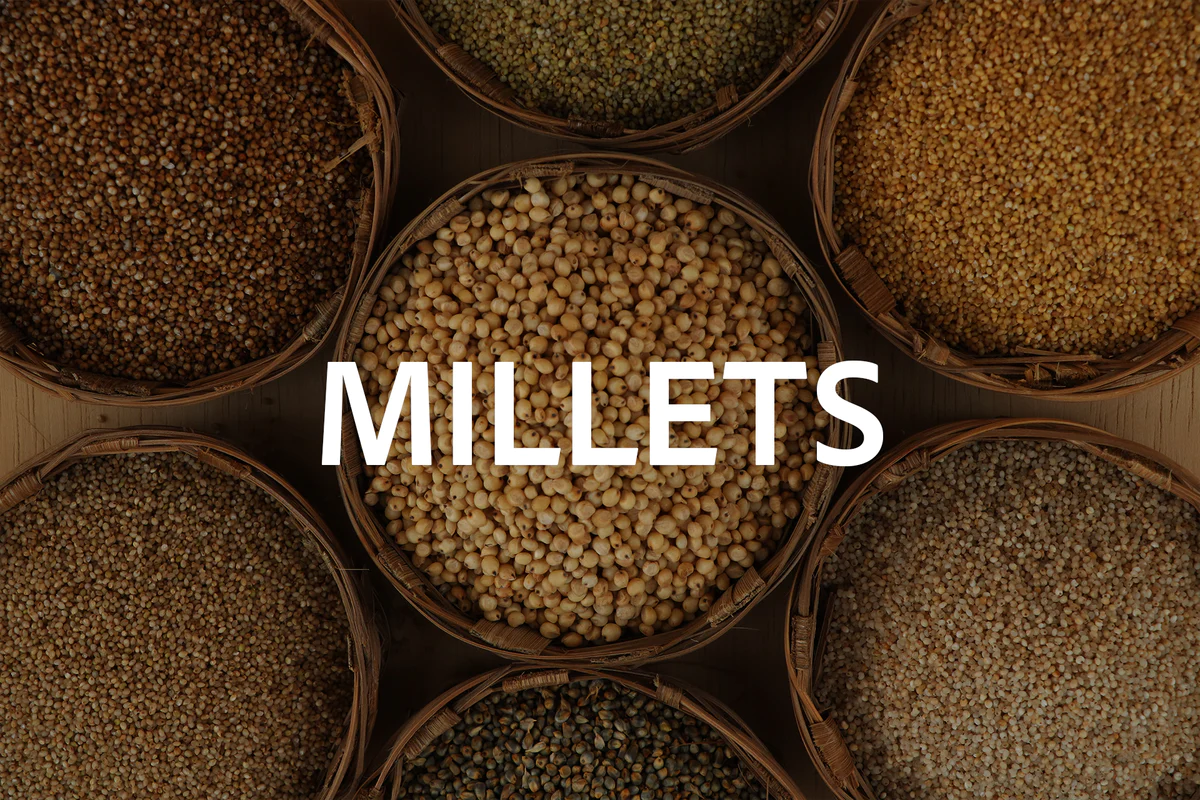In Asia and Africa, Millets were the first crops that humans ever farmed. Millet is a type of small-seeded grass that is grown for its grain, which is rich in nutrients and can be ground into flour or used as animal feed. It is highly adaptable and can grow in a wide range of environments, including dry and nutrient-poor soils, making it an important crop for farmers in areas prone to drought or soil degradation.
In addition to its potential for increasing food security, millet has many other benefits. It is a good source of nutrients, including protein, fiber, and vitamins, and has a low glycemic index, making it a healthy choice for people with diabetes or at risk of developing the disease. Millet is also a sustainable crop that requires minimal inputs and is resistant to pests and diseases, making it an attractive option for farmers looking to reduce their reliance on chemical inputs.
Millet is relatively easy to grow and can be harvested by hand, making it accessible to small-scale farmers and communities without access to mechanised agriculture. In India and other areas of the world, millets cultivation has significant potential to provide livelihoods, boost farmer income, and guarantee food and nutritional security.
However, Millets production has been facing roadblocks and the actual area and output of all major millet crops have declined, despite the government’s efforts to promote millets production. Millets, once a crucial component of human civilization’s diet, was supplanted in the post-green revolution era by other grains like wheat and rice.
Even though the MSPs of major millets increased by 80–125% between 2013–14 and 2021–22, their overall output had gradually decreased by 7% to 15.6 million tonnes over the preceding eight years due to farmers’ reluctance to expand towards the lack of government procurement at MSP, unlike in paddy and wheat. Jowar and Ragi production have both decreased, but bajra production has stayed consistent.
Until efforts are made to increase consumption, there won’t be enough encouragement for the farmers to switch to millets production. To make farmers shift their focus towards millet production some Policy-level interventions are required so that the farmers get remunerative prices for millets and their returns become higher than that of crops such as paddy.
The United Nations has designated 2023 as the ‘International Year of Millet (IYM)’ on India’s initiation with the objective to increase public awareness of millet’s significance and its potential to improve food security, nutrition, and sustainable agriculture. This yearly event offers the chance to draw attention to the vital role millet plays in sustaining the livelihoods of millions of people worldwide, especially in dryland regions where other crops may not be able to grow.
India is the largest producer of millets in the world. Millets are mainly grown in dry agroclimatic regions, particularly rainfed areas of the country. India produces over 170 lakh tonnes of millet, accounting for 80% of Asia’s and 20% of global production. Millet production has grown at 0.94% decadal CAGR from 16.03 million MT in 2012 to 17.60 million MT in 2022. The area under millets in India was 15.40 million ha in 2012 but declined to 14.00 million ha in 2022, registering a negative 0.95% CAGR (2012-22). The productivity of millets has risen from approximately 1.04 MT/ha in 2012 to 1.26 MT/Ha in 2022, registering a decadal CAGR of 2%.
Within India, Rajasthan was the largest producer of millets with a production of 5.15 million MT11 in 2020-21, contributing to 28.61% of the national production. Karnataka was the second largest contributor, producing 2.56 million MT and contributing 14.26% of national production. Other major millet-producing States included Maharashtra (2.51 million MT (13.95%)), Uttar Pradesh (2.29 million MT (12.75%)), Haryana (1.36 million MT (7.58%)) and Gujarat (1.09 million MT (6.06%)). These top 6 States contributed more than 80% of millet production in India in 2020-21.
In 2022, millet consumption in India was estimated to be 17.75 million MT12, growing at 1% decadal CAGR from 16.05 million MT in 2012. The per capita consumption of millets in India has dropped from 30.94 kg/annum in the year 1960 to 3.87 kg/annum in 202213. Production has mostly remained static, while the domestic population kept on increasing, thereby explaining the decline in per capita consumption.
The yields of millet production in different Indian States have been varying and low as compared to wheat and paddy. The national average is roughly 1 tonne for jowar, 1.5 tonnes for bajra, and 1.7 tonnes for ragi, as against 3.5 tonnes for wheat and 4 tonnes for paddy. With access to assured irrigation, they would tend to switch to rice, wheat, sugarcane, or cotton. Going forward, only higher profits in the wake of improved demand can encourage farmers to continue millet farming and prevent them from switching to other crops after receiving irrigation assurance.
Our honourable Finance Minister Nirmala Sitharaman devoted much-needed special focus to the millets in her recently concluded budget address. The relevance of coarse grains or millets has been emphasized as a method of sustainable farming that may increase the income of small farmers in dry regions, while also ensuring global food and nutritional security.
As the average Indian yield for millet production is 1239 kg/ha, compared to the global average yield of 1229 kg/ha. Nirmala Sitharaman proposed transforming the Indian Institute of Millet Research in Hyderabad into a center of excellence. This move aims to make India a global hub for millet research and to share best practices, research, and technology at the international level. She also emphasized that support will be provided for post-harvest value addition, enhancing domestic consumption, and for branding millet products nationally and internationally.
The government through its interventions should focus more on the steps, which can improve the consumption of millets. For instance, millets might become a mainstay of children’s diet as a part of their mid-day meal of over 26 crore enrolled students. Moreover, millets can also be a part of the supplementary nutrition provided to around 7.71 crore children and 1.80 crore pregnant & lactating women in the Anganwadi Care Centres.
The Centre’s ongoing schemes of Pradhan Mantri Poshan Shakti Nirman and Saksham Anganwadi & Poshan 2.0, which has a combined budget of Rs 30,496.82 crore can be made more millets focused.
Additional initiatives that can be undertaken to promote millets include-
Conducting awareness campaigns and training programs for farmers.
Investment in research and development, like developing new varieties of millets that are drought-resistant, disease-resistant, and have higher yields.
Government investment in irrigation infrastructure and provide subsidies for irrigation equipment to farmers as although the Millets are drought-tolerant crops, irrigation can still improve their yields.
Establishing market linkages like connecting farmers to buyers, processors, and exporters of millets can help increase the demand for millets.
Government and other organizations can provide extension services to farmers, such as providing technical assistance, soil testing, and crop management advice.
By implementing these measures, millet production in India can be increased, which can benefit farmers, consumers, and the overall economy.

Abhay Dandwate & Basant Vaid
National Bulk Handling Corporation





